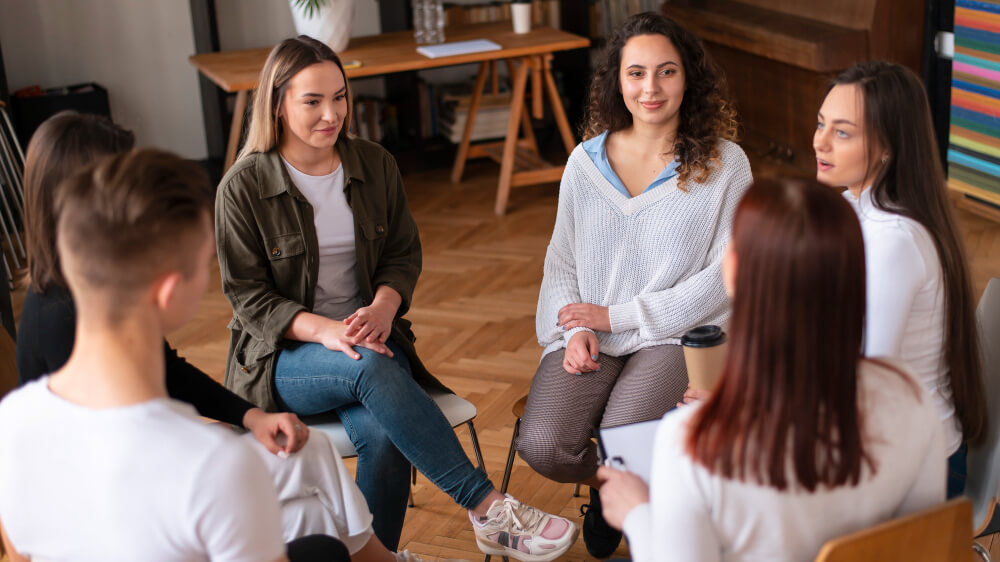Group Therapy in New York

Ever felt like you’re adrift in a turbulent sea, unsure how to reach solid ground? Now, picture others rowing beside you, sharing the same currents. That’s the essence of group therapy in NYC: a shared journey toward healing. Group therapy isn’t just a form of counseling; it’s a chance to address personal hurdles within a supportive network. This journey is difficult, and it takes courage and openness. But why travel alone when the power of a group will move you forward?
Here, we talk about how group therapy fosters awareness of emotions and builds relationships. We’ll also see how seasoned therapists conduct these sessions to provide confidentiality and protection. If human connection is power, buckle up and prepare to release a goldmine of it. Buckle up as we embark on the life-changing platform of group therapy and all that comes with it for personal development.
Finding Group Therapy
For the isolated in their struggles, group therapy has a special answer. Just picture a cozy setting where individuals with shared experiences are assembled to listen, give insight, and learn from each other.
What Is Group Therapy?
Group therapy is simply a therapist, quite possibly more than one, facilitating between five and fifteen members. Each group tends to be centered on a particular topic, like loss, anxiety, or chemical dependency.
This is where people can exchange personal experiences and inspire each other. It is an active exchange wherein everyone grows and develops.
How Group Therapy Is Different from Individual Therapy
Individual versus group therapy is not one or the other being superior, but each brings its own merits. Individual therapy is customized to each client, yet sometimes at the expense of depth from several sources. Group therapy, on the other hand, yields several input points. Seeing what others go through usually puts a different spin on one’s issues.
The Therapist’s Essential Role
Therapists form the pillars of group therapy. They establish a platform under which members are free to speak openly and share their feelings empathetically.
Leading the Group
Therapists set ground rules during sessions for respect, confidentiality, and open disclosure. They guide the process of discussion much like a conductor leads an orchestra, making sure every member is heard and that the discussion flows smoothly.
Laurie Sloane, an experienced therapist, describes how to equalize a group’s energy as both science and art.
Techniques of Engagement
Several techniques are used by therapists to activate engaging conversations, such as reflective questions, soft prompts, cognitive-behavioral exercises, and mindfulness exercises.
These sessions can become intense, especially when issues of a sensitive nature are discussed. The therapist has to navigate these sessions with caution so that safety is ensured without dampening authentic expression. Research indicates that group therapy, when facilitated correctly, leads to desired outcomes for many mental health concerns.
Safety and Confidentiality
For group therapy to be effective, individuals participating in the therapy have to feel safe.
Confidentiality
Privacy is important. Therapists usually set boundaries from the start, letting people know that what happens in the group there, stays there. This creates trust and enables free sharing.
Establishing a Safe Space
A safe space enables participants to speak freely without worrying about being judged. Therapists set an example and promote acceptance, and all voices are respected.
These ground rules form the basis for trust between participants, a prerequisite for them to participate fully in healing.
Laurie Sloane emphasizes that a very high level of safety gives participants confidence to move further into their own lives with the assurance that their contribution is appreciated and guarded.
Discovering Emotions Together
Group therapy is an effective means of unleashing emotions. Group members get to discover buried emotions and learn more about themselves.
Methods of Uncovering Emotions
Mindfulness strategies promote the appreciation of the here and now and taking responsibility for feelings. Cognitive-behavioral methods encourage a change in distorted thinking patterns.
Shared Journeys
Listening to others talk about the same issues brings a sense of belonging and empathy. Sharing suffering generates a community feeling where members do not feel isolated.
Counselors like Laurie Sloane focus on the power of validation—tuning in to the feelings and experiences of every member, leading to increased self-knowledge and growth.
Creating Healthier Relationships
Group therapy is not merely turning inward; it’s also learning new communication skills with others.
Creating Relationships
Groups provide an environment in which individuals experience things and connect with others through shared moments. Support group forms a strong bond and promote candor. Studies show that this sense of cohesion becomes an incentive to improved interpersonal relationships.
Learning New Skills
Role-playing or another interactive exercise during group sessions allows participants to rehearse good communication and conflict resolution in a positive setting.
These events also tend to transfer into more effective social skills and better relationships beyond the therapy room.
The Welcoming Atmosphere
Picture stepping into a room where everyone gets your dilemmas and wants you to succeed. That is what group therapy sets up.
Why It Matters
Humans are wired to relate and understand. The nurturing setting of group therapy offers an environment where people can become comfortable, exchange struggles, and celebrate triumphs together.
Experiments demonstrate that several report more benefit from group therapy than from individual therapy, especially for those wanting relationships and mutual understanding.
